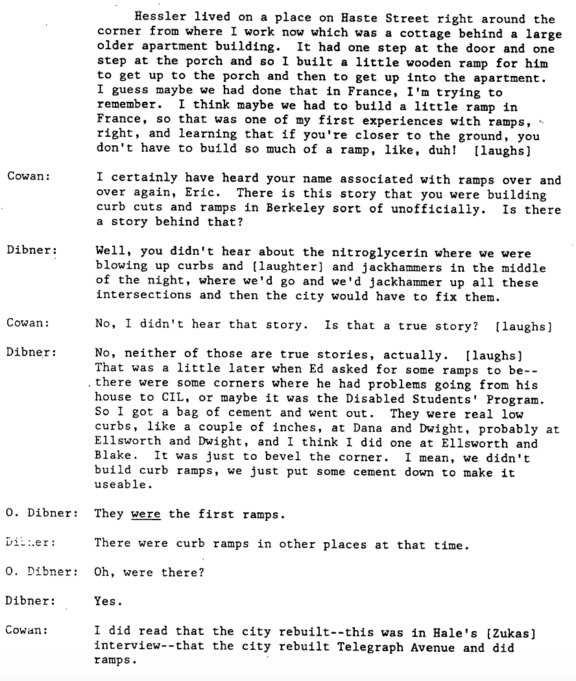Eric Dibner was an attendant to several leaders of the growing independent living movement, including John Hessler and Hale Zukas. He was active on the disability rights scene in Berkeley starting in 1967 at Cowell Hospital and worked on housing, transportation, and accessibility issues for both the Physically Disabled Students Program (PDSP) and Center for Independent Living (CIL).
Speaking to the location of Berkeley’s first curb ramp, Dibner corroborates Hale Zukas’s recollection that, between 1968 and 1969, the city of Berkeley made wheelchair-accessible the four blocks of Telegraph Avenue that are adjacent to campus (between Bancroft and Dwight). While there’s a good deal of mythology around the question of how the first curb cut came to Berkeley, it appears that Telegraph Avenue was an originary point of focus.
Dibner’s name also comes up in decades-old disability lore about activists taking to the street before dawn to demolish inaccessible street corners with sledgehammers and dynamite, thus forcing the city to repair them — this time with accessibility guidelines in mind.
In his oral history, Dibner refers to the legend of these acts of guerrilla intervention: “Well you didn’t hear about the nitroglycerin where we were blowing up curbs and jackhammers in the middle of the night, where we’d go and we’d jackhammer all these intersections and the city would have to fix them.”
When his interviewer Kathryn Cowan asks if the story is true, Dibner separated out truth from fiction, distinguishing between the dynamiting of non-accessible curbs (which he didn’t do) and the non-authorized adaptation of non-accessible curbs to make them accessible (which he did).
“No, neither of those are true stories, actually,” he said, referring to the accounts of blowing up the curbs of Berkeley. Then he described the unauthorized actions that he did participate in: “That was a little later when Ed (Roberts) asked for some ramps to be—there were some corners where he had problems going from his house to CIL, or maybe it was the Disabled Students’ Program. So I got a bag of cement and went out. They were real low curbs, like a couple of inches, at Dana and Dwight, probably at Ellsworth and Dwight, and I think I did one at Ellsworth and Blake. It was just to bevel the corner. I mean we didn’t build curb ramps, we just put some cement down to make it useable.”
While the guerrilla tactics deployed by Dibner and others were not amplified with dynamite, creating accessible space with DIY ethics can be interpreted as sites of disability protest. Reconfiguring material in the built environment revealed the malleability of spatial and social worlds. Akin to the socially constructed nature of disability, the material divisions preventing mobility for wheelchair users were, indeed, not fixed.
